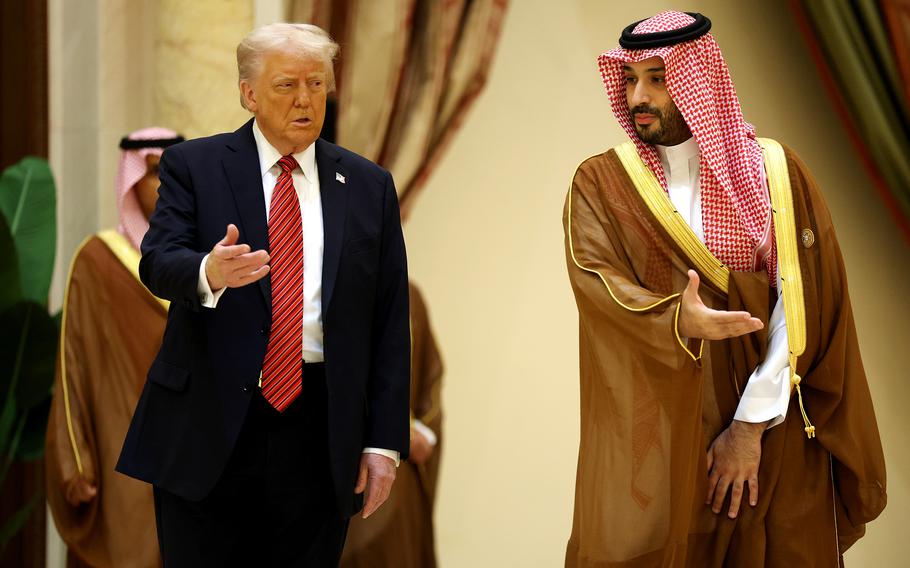
U.S. President Donald Trump and Saudi Crown Prince Mohammed bin Salman arrive during the Gulf Cooperation Council Leaders’ Summit at The Ritz-Carlton on May 14, 2025, in Riyadh, Saudi Arabia. (Win McNamee/Getty Images via TNS)
DUBAI, United Arab Emirates (Tribune News Service) — U.S. President Donald Trump ended his tour of the Middle East’s wealthiest countries touting new investments totaling a claimed $3.6 trillion — though upon closer inspection some of the deals may be overstated.
Trump’s four-day trip took him through Saudi Arabia, Qatar and the United Arab Emirates, where he lauded the countries’ deepening ties with the U.S. and took credit for a flurry of announcements. Some were non-binding or lacked specifics, raising questions about their true scale.
Aerospace and defense accords featured large and wide. Saudi Arabia led the charge with a $142 billion weapons agreement, which the Trump administration described as “the largest defense sales agreement in history.” The package was billed as covering everything from missile defense systems to coastal security, yet there was no concrete breakdown.
In Doha, Trump sat beside Boeing Chief Executive Officer Kelly Ortberg to sign a commercial deal with Qatar Airways, and while the president was unclear on the size and value of the deal — conferring with Ortberg at the ceremony — he was certain it was the largest in the U.S. planemaker’s history.
Trump initially stated the deal was worth $200 billion, but the White House later clarified that the figure was $96 billion, a number that still appears to be overstated.
The order included 130 Boeing 787 Dreamliners and 30 777X jets, with options for 50 more — though it lacked specifics on aircraft variants. A more realistic estimate, based on valuations provided by aviation consultant Ishka, puts the value of the firm order below $30 billion after typical industry discounts. The White House and Ortberg later specified that it was Boeing’s largest-ever widebody aircraft sale.
While the figures may be fuzzy, they also may not really matter. The trip reinforced the importance of U.S.-gulf relations, and Trump succeeded in projecting an image of an American administration open for business after his tariff broadsides shocked the global economy. Boeing’s stock soared, as investors saw progress in Ortberg’s turnaround.
Saudi Arabia’s sovereign wealth fund also placed an order for 20 Boeing Co. 737 Max jets, with options for 10 more. While the White House valued the deal at $4.8 billion, Ishka’s valuations show the order’s actual worth is closer to $1.5 billion — and that’s if the fund decides to firm up the options.
At Trump’s final stop in the UAE, national carrier Etihad Airways confirmed an order for 28 787 and 777X widebody aircraft, which Washington valued at $14.5 billion.
Yet again, the substance was less than met the eye: the deal appeared to be either a restructured version of a previous agreement or a formal confirmation of a previous commitment.
The airline didn’t specify how many it would buy of each model, but the deal could potentially be worth up to $5.4 billion if all planes ordered were of the more expensive 777X.
One possible accord that made waves before Trump arrived remained elusive: a giant 747-8 jumbo owned by Qatar that had been floated as a possible gift. On Friday, Trump left again the same way he had arrived: onboard his decades-old Air Force One.
Global leaders from the U.S. and other nations have a long history of repackaging older agreements as new deals during presidential trips abroad. The flurry of news releases and photo ops may not have a major effect on long-term commitments or new investments going into the US.
Even so, Trump managed to go a step beyond his own past performance in the role of U.S. salesman-in-chief.
During a first-term trip in 2017, Trump announced Saudi Arabia would spend $110 billion on U.S. weapons to modernize its military. That package, which included initiatives started by the Obama administration, has yielded more than $30 billion in military sales, according to a State Department fact sheet in January.
During the latest Mideast trip, Trump floated similarly murky plans for America’s fighter jets. In Qatar, he mused that the U.S. would develop a twin-engine version of the F-35 fighter jet, despite the fact that the stealthy attack aircraft is designed around a single turbine.
“I think we’re going to call it the F-55, which will be a double engine plane,” he said. “I like two engines on a plane.”
He later said the U.S. would pursue an upgraded version of the F-22 air-superiority fighter. That plane, out of production for more than a decade, is already slated to be succeeded by the next-generation F-47, which was recently awarded to Boeing.
“I think the most beautiful fighter jet in the world is the F-22, but we’re going to do an F-22 Super,” Trump said. “And it’ll be a very modern version of the F-22 fighter jet.”
Ryan Beene contributed to this report.
©2025 Bloomberg L.P.
Visit bloomberg.com.
Distributed by Tribune Content Agency, LLC.